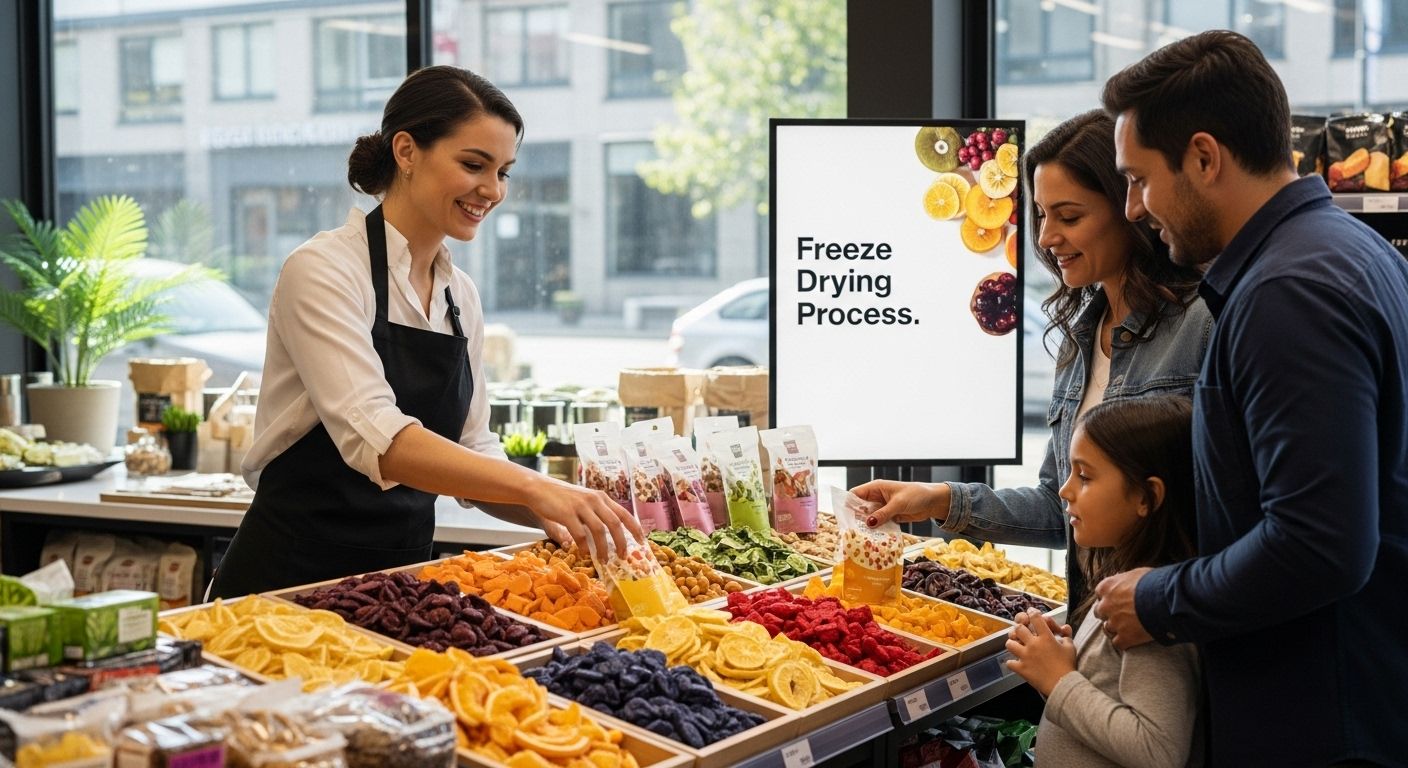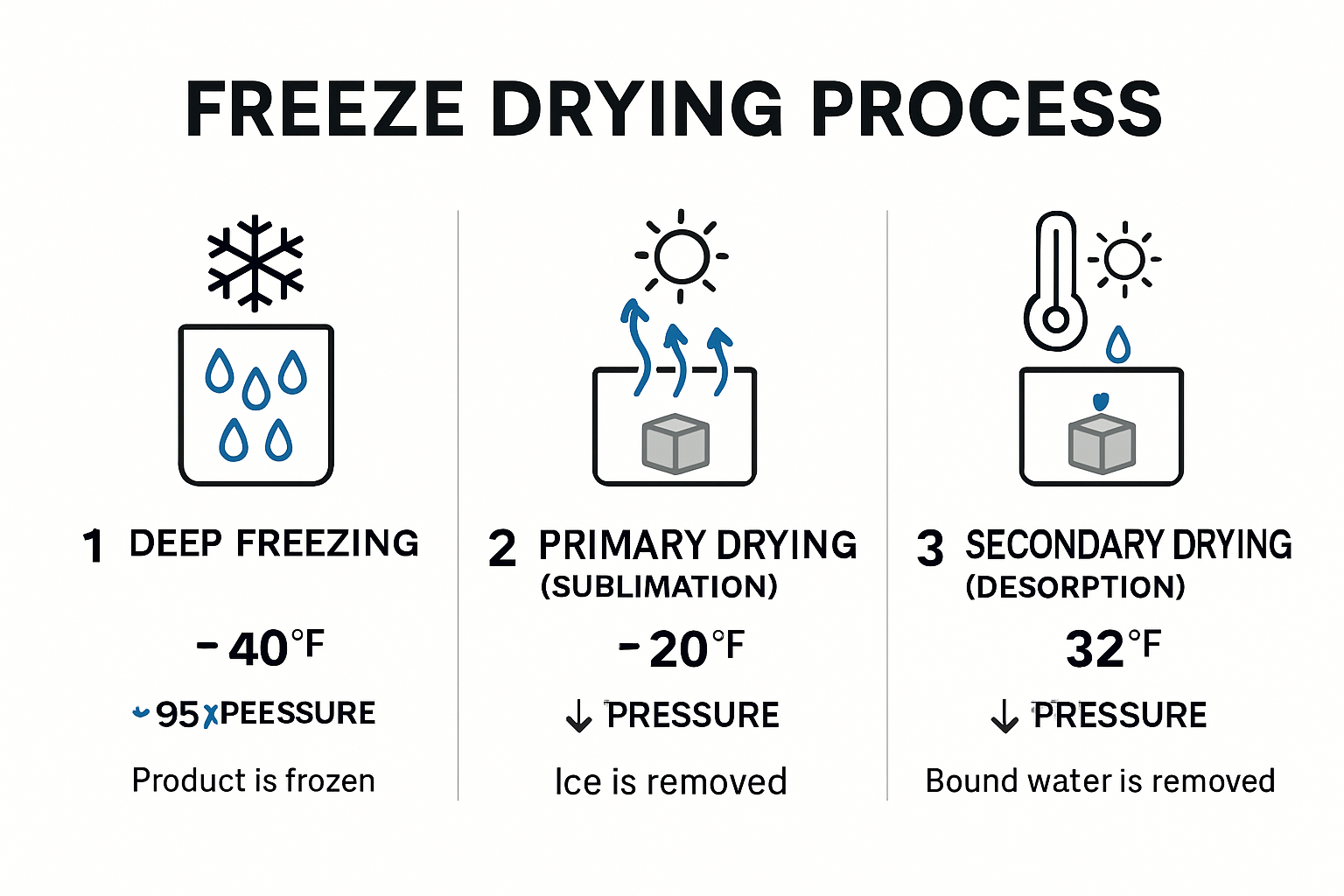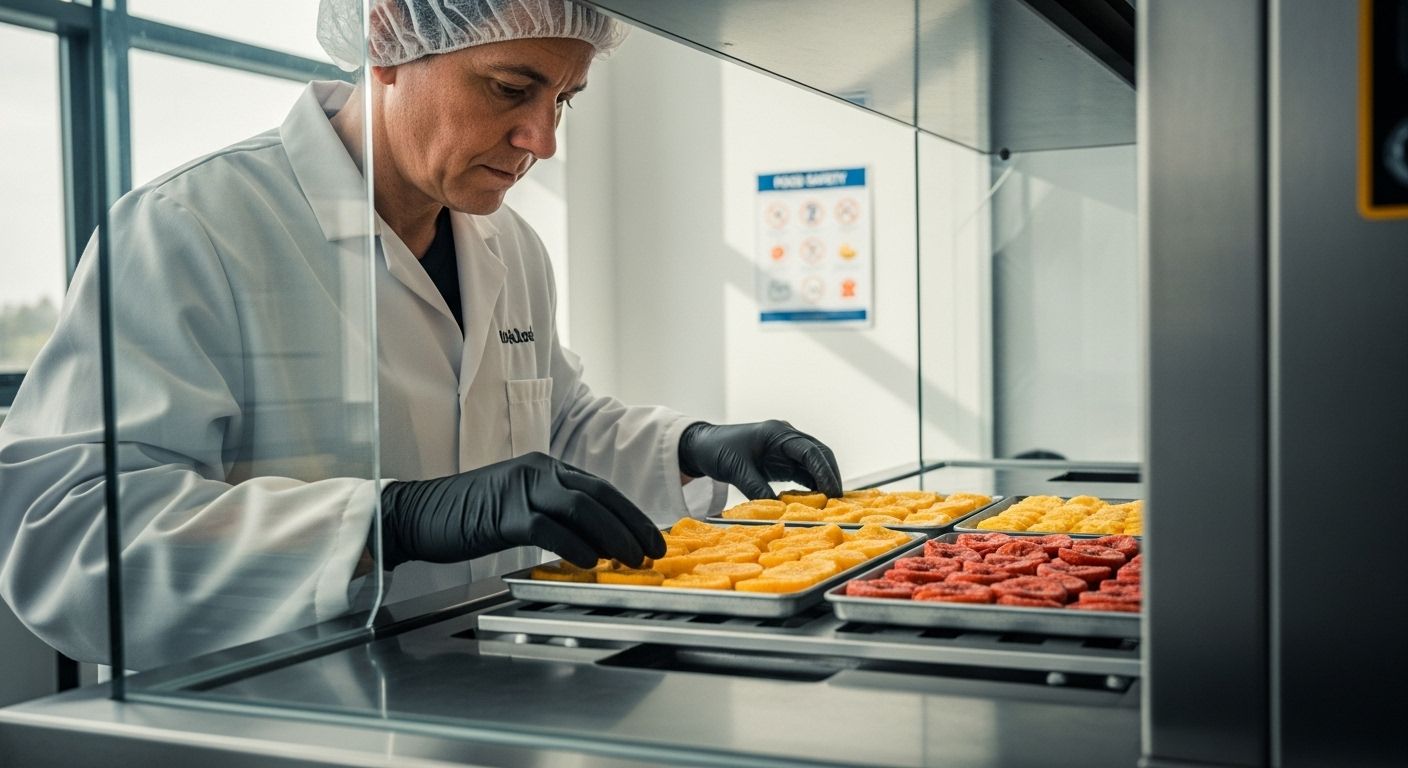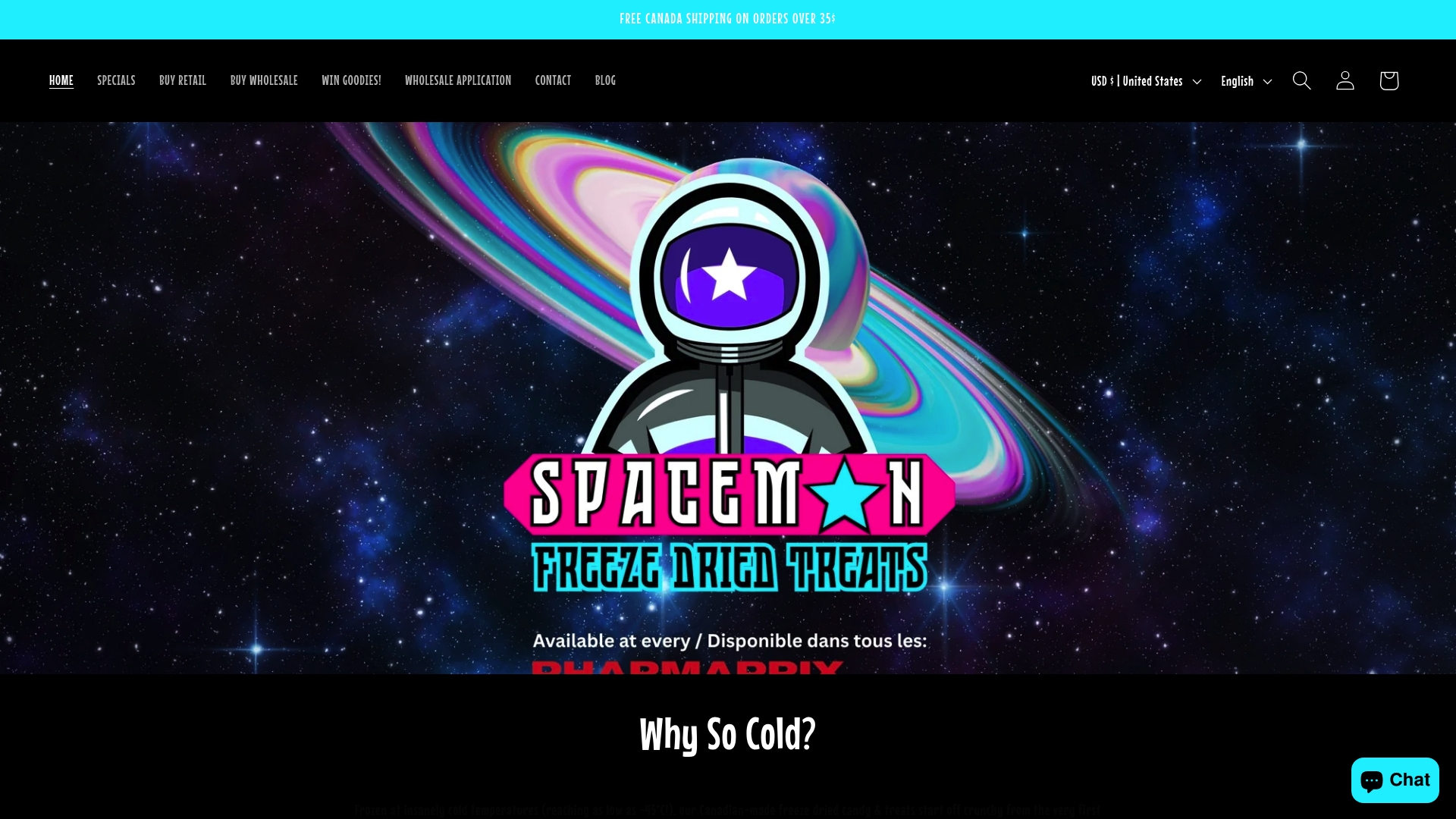
Freeze drying is everywhere now, from crunchy astronaut ice cream to those curious berries in your snack aisle. You might guess it’s all about futuristic technology or outer space rations. Surprisingly, the biggest impact comes right to your pantry, since freeze dried foods can last up to 25 years and retain up to 97% of their original nutrients. That means the next snack you try might be fresher, healthier, and more interesting than anything your grandparents ever had.
Table of Contents
- How Freeze Drying Works Step by Step
- Freeze Drying Benefits for Retailers and Manufacturers
- Popular Products Made With Freeze Drying
- Tips for Choosing Freeze Dried Snacks and Suppliers
Quick Summary
| Takeaway | Explanation |
|---|---|
| Freeze drying extends shelf life significantly | Products can last up to 25 years, reducing spoilage and waste for retailers and manufacturers. |
| Nutritional integrity is preserved | Freeze drying retains up to 97% of original nutrients, appealing to health-conscious consumers. |
| Versatile applications across industries | This technology is suitable for snacks, pharmaceuticals, and space nutrition, enhancing product development. |
| Choose suppliers with safety certifications | Ensure suppliers follow robust safety protocols to prevent foodborne illnesses in freeze-dried products. |
| Optimal packaging is essential | Use Mylar bags and proper sealing to extend freshness and prevent moisture damage to freeze-dried items. |
How Freeze Drying Works Step by Step
Freeze drying transforms food preservation through a sophisticated scientific process that maintains nutritional integrity and flavor. Understanding the intricate steps of freeze-drying reveals why this method has become so revolutionary for food storage and quality preservation.
The Three Critical Stages of Freeze Drying
The freeze-drying process follows a precise sequence of carefully controlled stages that systematically remove moisture while preserving the food’s original structure and nutrients. According to the University of Minnesota Extension, these stages are meticulously designed to ensure optimal food preservation.
Stage 1: Deep Freezing
The initial stage involves rapidly freezing the food product at extremely low temperatures ranging between -30 to -50 degrees Fahrenheit. This ultra-rapid freezing creates microscopic ice crystals throughout the food, which is crucial for maintaining the product’s cellular structure. By freezing quickly, the food’s original shape, color, and nutritional profile remain intact. As Penn State Extension explains, the precise temperature control during this phase prevents large ice crystal formation that could damage the food’s cellular walls.
Stage 2: Primary Drying (Sublimation)
During the primary drying phase, a vacuum pump removes air from the chamber, creating an environment where ice can transform directly from solid to vapor without passing through the liquid state. This process, known as sublimation, removes approximately 90% of the water content. The chamber’s pressure is dramatically reduced, and mild heat is applied, causing the ice crystals to evaporate. NCBioNetwork.org highlights that this stage requires extremely precise temperature and pressure control to ensure the food’s structural integrity remains uncompromised.
Stage 3: Secondary Drying (Desorption)
The final stage focuses on removing the remaining 1-2% of moisture from the food’s surface. During secondary drying, slightly higher temperatures are used to extract any residual moisture molecules bound within the food’s cellular structure. This meticulous process ensures that the final product is thoroughly dehydrated while maintaining its original flavor, nutritional value, and appearance.
Here is a step-by-step summary of the three critical stages in the freeze-drying process, outlining the main actions and their effects at each phase.
| Stage | Main Action | Purpose/Effect |
|---|---|---|
| Deep Freezing | Rapid freezing at -30 to -50°F | Preserves cellular structure, shape, color, and nutrition |
| Primary Drying (Sublimation) | Vacuum removes air, mild heat causes ice to turn to vapor | Removes ~90% of water without melting, maintains structural integrity |
| Secondary Drying (Desorption) | Slightly higher temperatures remove remaining surface moisture | Final dehydration ensures long shelf life, retains flavor and nutritional value |
By understanding these intricate steps, it becomes clear why freeze drying represents such an advanced food preservation technique. The method goes far beyond traditional dehydration, offering a scientifically precise approach to removing moisture while preserving the food’s essential qualities.

The beauty of the freeze-drying process lies in its ability to create lightweight, long-lasting food products that can be easily stored, transported, and reconstituted without significant quality loss. Whether it’s for emergency food supplies, space exploration, or gourmet snack production, freeze drying continues to revolutionize how we think about food preservation.
Freeze Drying Benefits for Retailers and Manufacturers
Freeze drying represents a game changing technology that offers substantial advantages for retailers and manufacturers seeking innovative food preservation and product development strategies. Understanding these benefits can transform business operations and market competitiveness.
Extended Product Shelf Life and Reduced Waste
One of the most significant advantages of freeze drying is its ability to dramatically extend product shelf life. According to Food Technology Magazine, freeze-dried products can maintain quality for up to 25 years when properly stored, compared to traditional preservation methods that typically offer much shorter preservation windows. This extraordinary longevity translates into profound economic benefits for manufacturers and retailers.
Key Economic Advantages:
- Reduced Spoilage: Minimizes inventory loss and associated financial risks
- Lower Storage Costs: Lightweight products require less expensive storage infrastructure
- Extended Distribution Channels: Enables shipping and selling products across broader geographic regions
Enhanced Product Quality and Consumer Appeal
Freeze drying maintains the original nutritional profile, flavor, and structural integrity of food products in ways traditional preservation methods cannot match. Journal of Food Science research indicates that freeze-dried foods retain up to 97% of their original nutritional content, making them exceptionally attractive to health-conscious consumers.
Consumer Perception Benefits:
- Nutritional Integrity: Preserves vitamins, minerals, and essential nutrients
- Authentic Taste: Maintains original flavor profiles
- Lightweight Packaging: Creates convenient, portable food options
Versatility Across Multiple Product Categories
The freeze-drying process offers unprecedented versatility for manufacturers across diverse industries. From gourmet snacks and emergency food supplies to pharmaceutical ingredients and scientific research materials, this technology provides innovative solutions for product development and preservation.
Potential Application Areas:
- Specialty food manufacturing
- Outdoor and camping supply markets
- Pharmaceutical ingredient preservation
- Aerospace and military nutrition programs
- Specialty pet food production
Manufacturers who embrace freeze-drying technology position themselves at the forefront of food innovation. By offering products with superior shelf life, maintained nutritional quality, and enhanced consumer appeal, businesses can differentiate themselves in increasingly competitive markets.
The economic and practical benefits of freeze drying extend far beyond simple food preservation. This technology represents a strategic investment in product quality, operational efficiency, and long-term market competitiveness. Retailers and manufacturers who understand and leverage these advantages will be well-equipped to meet evolving consumer demands and industry trends.
Popular Products Made With Freeze Drying
Freeze drying has revolutionized product development across multiple industries, creating innovative and high-quality food items that captivate consumers with their exceptional taste, nutritional value, and convenience. Understanding the diverse range of freeze-dried products reveals the remarkable versatility of this preservation technique.
Gourmet Snacks and Fruit Innovations
The snack industry has embraced freeze-drying as a transformative technology for creating unique and appealing products. According to research published in the journal Foods, freeze-dried fruits and vegetable chips have become increasingly popular among health-conscious consumers. These lightweight, crunchy snacks retain nearly all of their original nutritional content while offering an intense flavor profile that traditional dehydration methods cannot achieve.
Popular Freeze-Dried Fruit Products:
- Strawberry Crisps: Whole strawberries transformed into crispy, intensely flavored snacks
- Apple Chips: Thin, lightweight fruit slices with concentrated natural sweetness
- Mixed Berry Blends: Combinations of freeze-dried raspberries, blueberries, and blackberries
Beverage and Dairy Innovations
Beverage and dairy manufacturers have discovered remarkable applications for freeze-drying technology. Instant coffee, long a staple of convenience, has been revolutionized by freeze-drying techniques that preserve the coffee’s original flavor and aroma. Dairy products have also seen significant innovation, with freeze-dried ice cream becoming a particularly interesting product category.
Unique Freeze-Dried Beverage and Dairy Products:
- Instant Specialty Coffee: Gourmet coffee varieties that maintain complex flavor profiles
- Astronaut Ice Cream: A classic example of freeze-dried dairy product used in space exploration
- Powdered Milk: Lightweight, long-lasting dairy products for global distribution
Pharmaceutical and Specialty Applications
Beyond the food industry, freeze-drying has become critical in pharmaceutical and scientific research. Medications, biological samples, and specialized ingredients benefit from the precise moisture removal and preservation capabilities of freeze-drying technology.
Advanced Freeze-Drying Applications:
- Pharmaceutical Ingredients: Preserving sensitive medications and biological compounds
- Herbal Supplements: Maintaining the potency of natural health products
- Scientific Research Samples: Preserving delicate biological and chemical specimens
The versatility of freeze-drying continues to inspire innovation across industries. From gourmet snacks that deliver intense flavors to critical pharmaceutical applications, this preservation technique offers unprecedented opportunities for product development and quality maintenance.
Below is a summary table comparing popular categories of freeze-dried products, their typical examples, and key consumer benefits, based directly on what is discussed in the article.
| Product Category | Typical Examples | Key Benefits for Consumers |
|---|---|---|
| Gourmet Snacks & Fruits | Strawberry crisps, apple chips, berry blends | High nutrition, intense flavor, light & portable |
| Beverage & Dairy | Instant specialty coffee, astronaut ice cream, powdered milk | Preserved flavor, long shelf life, convenience |
| Pharmaceuticals & Specialty | Medications, herbal supplements, research samples | Stability, potency preservation, precise storage |
Consumers increasingly seek products that combine convenience, nutritional integrity, and exceptional taste. Freeze-dried products perfectly meet these demands, providing lightweight, long-lasting options that do not compromise on quality. As technology advances, we can expect even more exciting and innovative applications of freeze-drying in the years to come.
Tips for Choosing Freeze Dried Snacks and Suppliers
Selecting the right freeze-dried snacks and suppliers requires careful consideration of multiple factors beyond simple taste and packaging. Informed decision making can help businesses and consumers maximize the quality, safety, and value of their freeze-dried product selections.
Food Safety and Quality Considerations
Food safety is paramount when choosing freeze-dried products. According to the University of Minnesota Extension, freeze-drying does not automatically eliminate illness-causing microorganisms. This critical insight means buyers must prioritize suppliers with robust food safety protocols.
Key Safety Evaluation Criteria:

- Processing Certifications: Look for suppliers with recognized food safety certifications
- Ingredient Transparency: Detailed ingredient lists and sourcing information
- Water Activity Levels: Ensure products have water activity at 0.85 or below, which inhibits microbial growth
Packaging and Storage Recommendations
Proper packaging significantly impacts the longevity and quality of freeze-dried products. The Sustainable Agriculture Research and Education (SARE) program provides comprehensive packaging recommendations for maintaining product integrity.
Optimal Packaging Strategies:
- Mylar Bags: 7-mil thickness with oxygen absorbers for long-term storage
- Gusseted Bags: Zip-lock tops for delicate items like herbs
- Moisture Barrier: Packaging that prevents humidity infiltration
Supplier Selection and Evaluation Techniques
Choosing the right supplier goes beyond product quality. Consider factors that demonstrate a supplier’s commitment to innovation, consistency, and customer satisfaction.
Supplier Assessment Factors:
- Production Consistency: Request sample batches to evaluate quality
- Customization Options: Ability to meet specific business requirements
- Technical Support: Suppliers offering comprehensive product guidance
- Minimum Order Quantities: Flexibility in order sizes
- Shipping and Handling Capabilities: Ensuring product arrives in optimal condition
By implementing a comprehensive evaluation approach, businesses can identify freeze-dried product suppliers that not only meet but exceed expectations. The right supplier provides more than just a product they become a strategic partner in delivering high-quality, innovative food solutions.
Remember that the freeze-dried snack market continues to evolve rapidly. Staying informed about emerging technologies, safety standards, and consumer preferences will help businesses make intelligent sourcing decisions. Prioritize suppliers who demonstrate a commitment to quality, safety, and continuous improvement in their freeze-drying processes.
Frequently Asked Questions
What is the freeze drying process?
Freeze drying is a preservation method that removes moisture from food by first freezing it and then using a vacuum environment to turn the ice directly into vapor, preserving the food’s structure, flavor, and nutrients.
How long do freeze dried foods last?
Freeze dried foods can last up to 25 years when properly stored, making them an excellent option for long-term food storage and reducing waste.
What are the nutritional benefits of freeze dried foods?
Freeze drying retains up to 97% of the original nutrients in food, making freeze dried options highly nutritious and appealing to health-conscious consumers.
How should freeze dried snacks be stored?
Freeze dried snacks should be stored in airtight containers, preferably Mylar bags with oxygen absorbers, to extend freshness and prevent moisture damage.
Ready to Transform Your Snack Aisle with Freeze Dried Innovation?
After learning about the science and benefits of freeze drying in our guide, you might be wondering how to bring long-lasting, nutrient-rich, and crowd-pleasing snacks into your own product line or store. Business owners and snack lovers alike face real challenges: wasted inventory, short shelf life, and limited options for healthy, bold flavors. With Space Man, you gain a partner who not only manufactures and distributes top-quality freeze dried candy in Canada, but also delivers private labeling, co-packing, and flexible packaging solutions that directly address these industry pain points discussed in the article.

Take the next step toward premium freeze dried snacks that stand out on your shelves and satisfy the growing demand for quality and convenience. Visit our homepage now to explore our full manufacturing capabilities, or contact our team to learn how tailored packaging and B2B or B2C options can support your business goals. Do not wait—secure your access to products with up to 25-year shelf life and unmatched flavor retention today.
Recommended
- How to Start Selling Freeze-Dried Candy as a Business – Spaceman
- Why Distributors Across Canada Are Adding Freeze-Dried Candy to Their – Spaceman
- How to Launch Your Own Freeze-Dried Candy Brand in Canada (Without a F – Spaceman
- How Calgary Retailers and Distributors Are Driving Repeat Sales with F – Spaceman

